Results
-
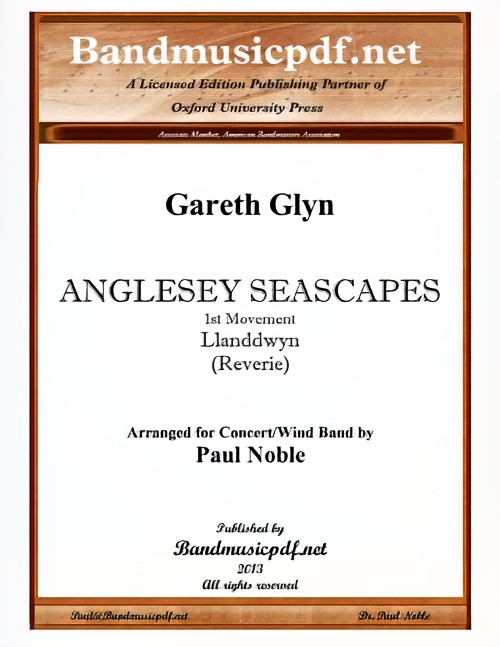 £65.00
£65.00Anglesey Seascapes, 1st Movement (Concert Band - Score and Parts) - Glyn, Gareth - Noble, Paul
Gareth Glyn lives on the island of Anglesey, where the encircling sea has always been indivisible from the mythology, history and everyday life and work of its people. This cycle of short miniatures, in a light music vein, seeks to represent various aspects of the sea as seen from five vantagepoints around the coast of Anglesey. The whole work is bound together by recurring musical motifs which change their character according to the prevailing mood. 1. Llanddwyn (Reverie): Island of the Welsh patron saint of lovers, Dwynwen, whose marriage to Maelon was never to be, and who dedicated her life to God. 2. Malltraeth (Pastorale): A brisk walk along Cob Malltraeth, a high dyke built to keep out the sea. 3. Penmon (Intermezzo): From a vantage point by the sacred priory of St Seiriol, old sailing ships and modern yachts can be seen scudding by in Regatta week. 4. Cemaes (Scherzo): The bustle of children's play and donkey-rides on the beach in midsummer. 5. Moelfre (Elegy): In remembrance of innumerable souls lost in shipwrecks off this coast, including the Royal Charter with its loss of 452 lives.
Estimated dispatch 7-14 working days
-
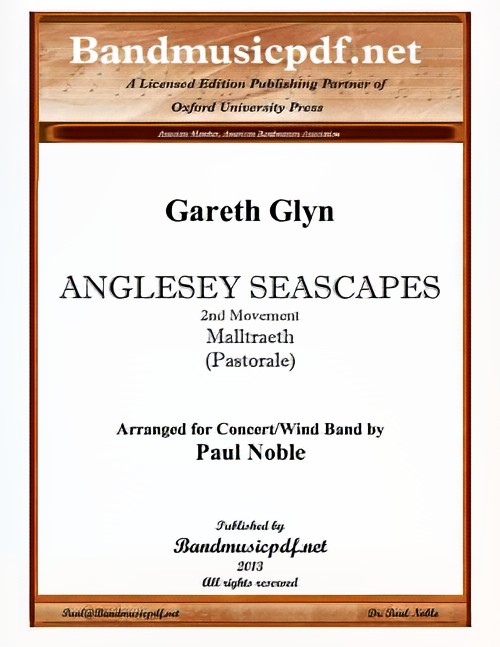 £65.00
£65.00Anglesey Seascapes, 2nd Movement (Concert Band - Score and Parts) - Glyn, Gareth - Noble, Paul
Gareth Glyn lives on the island of Anglesey, where the encircling sea has always been indivisible from the mythology, history and everyday life and work of its people. This cycle of short miniatures, in a light music vein, seeks to represent various aspects of the sea as seen from five vantagepoints around the coast of Anglesey. The whole work is bound together by recurring musical motifs which change their character according to the prevailing mood. 1. Llanddwyn (Reverie): Island of the Welsh patron saint of lovers, Dwynwen, whose marriage to Maelon was never to be, and who dedicated her life to God. 2. Malltraeth (Pastorale): A brisk walk along Cob Malltraeth, a high dyke built to keep out the sea. 3. Penmon (Intermezzo): From a vantage point by the sacred priory of St Seiriol, old sailing ships and modern yachts can be seen scudding by in Regatta week. 4. Cemaes (Scherzo): The bustle of children's play and donkey-rides on the beach in midsummer. 5. Moelfre (Elegy): In remembrance of innumerable souls lost in shipwrecks off this coast, including the Royal Charter with its loss of 452 lives.
Estimated dispatch 7-14 working days
-
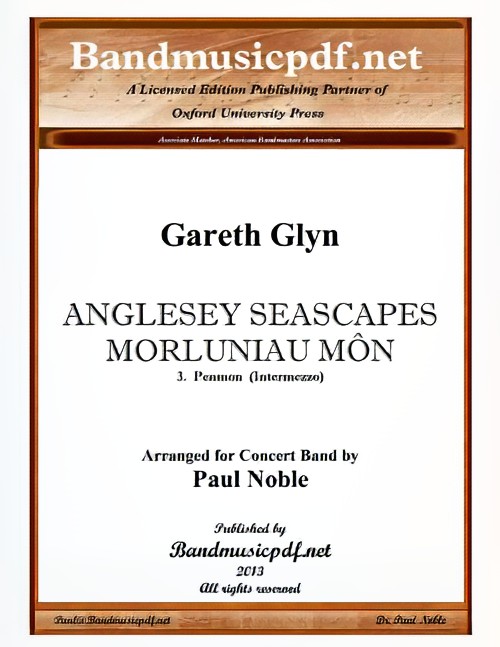 £65.00
£65.00Anglesey Seascapes, 3rd Movement (Concert Band - Score and Parts) - Glyn, Gareth - Noble, Paul
Gareth Glyn lives on the island of Anglesey, where the encircling sea has always been indivisible from the mythology, history and everyday life and work of its people. This cycle of short miniatures, in a light music vein, seeks to represent various aspects of the sea as seen from five vantagepoints around the coast of Anglesey. The whole work is bound together by recurring musical motifs which change their character according to the prevailing mood. 1. Llanddwyn (Reverie): Island of the Welsh patron saint of lovers, Dwynwen, whose marriage to Maelon was never to be, and who dedicated her life to God. 2. Malltraeth (Pastorale): A brisk walk along Cob Malltraeth, a high dyke built to keep out the sea. 3. Penmon (Intermezzo): From a vantage point by the sacred priory of St Seiriol, old sailing ships and modern yachts can be seen scudding by in Regatta week. 4. Cemaes (Scherzo): The bustle of children's play and donkey-rides on the beach in midsummer. 5. Moelfre (Elegy): In remembrance of innumerable souls lost in shipwrecks off this coast, including the Royal Charter with its loss of 452 lives.
Estimated dispatch 7-14 working days
-
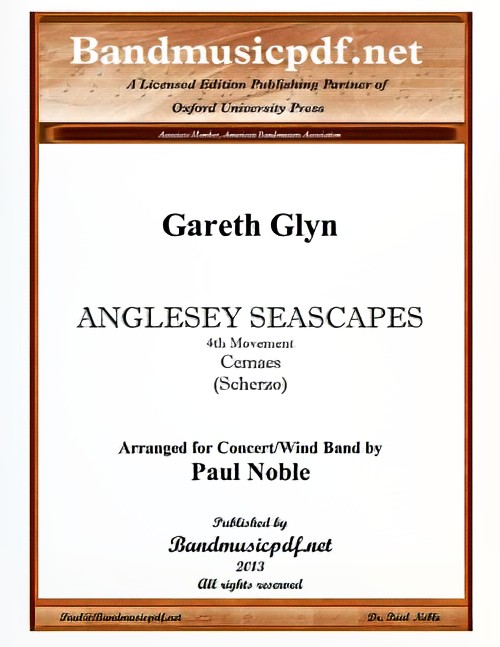 £65.00
£65.00Anglesey Seascapes, 4th Movement (Concert Band - Score and Parts) - Glyn, Gareth - Noble, Paul
Gareth Glyn lives on the island of Anglesey, where the encircling sea has always been indivisible from the mythology, history and everyday life and work of its people. This cycle of short miniatures, in a light music vein, seeks to represent various aspects of the sea as seen from five vantagepoints around the coast of Anglesey. The whole work is bound together by recurring musical motifs which change their character according to the prevailing mood. 1. Llanddwyn (Reverie): Island of the Welsh patron saint of lovers, Dwynwen, whose marriage to Maelon was never to be, and who dedicated her life to God. 2. Malltraeth (Pastorale): A brisk walk along Cob Malltraeth, a high dyke built to keep out the sea. 3. Penmon (Intermezzo): From a vantage point by the sacred priory of St Seiriol, old sailing ships and modern yachts can be seen scudding by in Regatta week. 4. Cemaes (Scherzo): The bustle of children's play and donkey-rides on the beach in midsummer. 5. Moelfre (Elegy): In remembrance of innumerable souls lost in shipwrecks off this coast, including the Royal Charter with its loss of 452 lives.
Estimated dispatch 7-14 working days
-
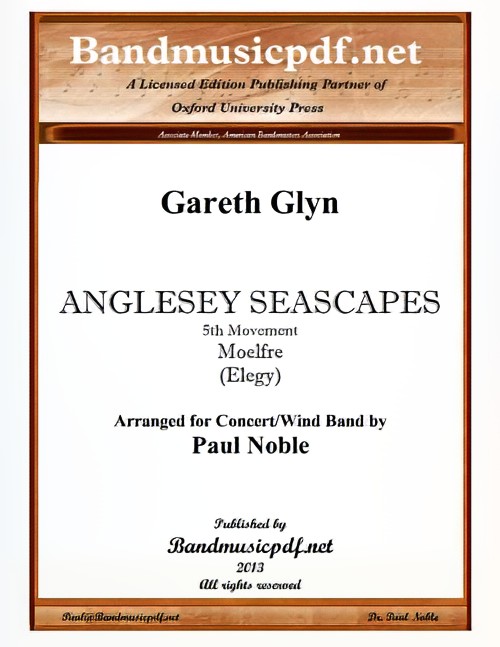 £65.00
£65.00Anglesey Seascapes, 5th Movement (Concert Band - Score and Parts) - Glyn, Gareth - Noble, Paul
Gareth Glyn lives on the island of Anglesey, where the encircling sea has always been indivisible from the mythology, history and everyday life and work of its people. This cycle of short miniatures, in a light music vein, seeks to represent various aspects of the sea as seen from five vantagepoints around the coast of Anglesey. The whole work is bound together by recurring musical motifs which change their character according to the prevailing mood. 1. Llanddwyn (Reverie): Island of the Welsh patron saint of lovers, Dwynwen, whose marriage to Maelon was never to be, and who dedicated her life to God. 2. Malltraeth (Pastorale): A brisk walk along Cob Malltraeth, a high dyke built to keep out the sea. 3. Penmon (Intermezzo): From a vantage point by the sacred priory of St Seiriol, old sailing ships and modern yachts can be seen scudding by in Regatta week. 4. Cemaes (Scherzo): The bustle of children's play and donkey-rides on the beach in midsummer. 5. Moelfre (Elegy): In remembrance of innumerable souls lost in shipwrecks off this coast, including the Royal Charter with its loss of 452 lives.
Estimated dispatch 7-14 working days
-
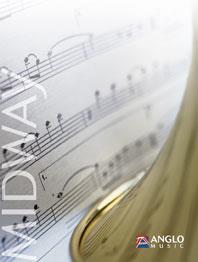 £110.99
£110.99The Harbour: Sunday Morning (Concert Band - Score and Parts) - Sparke, Philip
The Harbour: Sunday Morning was commissioned by the Jersey Instrumental Service for the Jersey Youth Wind Band. The history of the Channel Islands is inextricably linked to the sea and this determined the theme for this composition. The composer is intrigued by man's fascination with elements of nature (such as the sea, mountains, deserts and deep space), which are both beautiful and dangerous. Bring the power of the sea to your concert with this truly descriptive piece.Duration: 7:00
Estimated dispatch 7-14 working days
-
 £82.95
£82.95Rising Dragons (Concert Band - Score and Parts) - Smith, Robert W.
Commissioned by the Korean Navy Symphonic Band under the direction of Lt. Commander Joon Hyung Park, Rising Dragons pays tribute to the legacy of Yi Sun Shin and his impact on naval operations throughout the world. Beginning with a commanding fanfare, the authoritative statement gives way to the lone flute representing the solitude and reflection that any great leader must endure. The mechanized sounds of the turtle ships are brought to musical life through melody that rises and falls like the sea. The sea battle is depicted with opposing forces of percussion giving way to a final victorious fanfare. A line from a poem written by Yi Sun Shin inspires the title: "I call to the sea, and the dragons are moved."Duration: 9.15
Estimated dispatch 7-14 working days
-
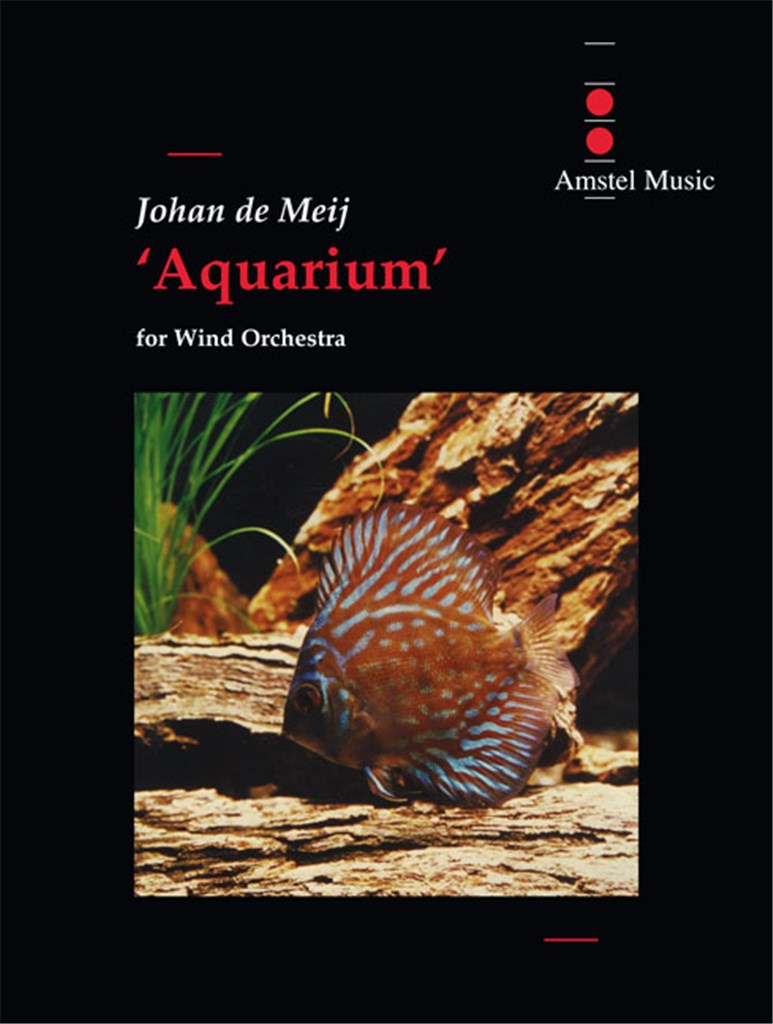 £128.00
£128.00Aquarium (Concert Band - Score and Parts) - De Meij, Johan
The Suite Aquarium is Johan de Meij's third composition for symphonic band and features six tropical fishes, each of them represented by a motif, and surfacing as such in several guises. The composition consists of three movements of which the second and third merge uninterruptedly into each other. I) Allegretto grazioso (Neon Tetra, Electric Eel and Angelfish) II) Andante / Adagio (Sea Horse and Zebrafish) III) Finale: Allegro giocoso (Guppy & Co.) The Neon Tetra motif functions as a kind of 'Leitmotiv' and describes the beautifully coloured, frisky fish: A number of variants have been derived from this theme and will also appear in the other movements. The Electric Eel in fact is not represented by a motif, but by a rhythm based on the restless electric pulses made audible in some aquaria. The Angel fish is represented by elegant cluster chords. In the second movement the Sea Horse emerges out of the water vegetation and starts a dialogue with the Zebrafish, which is represented by one melodic phrase in unison, getting more and more threatening by added parallel fifths and octaves. Simultaneously with the Sea Horse motif the Neon Tetra theme emerges, this time in 3/4 time and in Eb minor. The third movement starts with only two instruments (trumpet and xylophone), but as it is often the case with Guppies their number rapidly increases. Piccolo and Alto Saxophone introduce the Guppy Theme followed by several instrumental combinations. Every theme from the first movement 'swims by' once more, after which the principal motif leads us to a brilliant ending.Duration: 9.00
Estimated dispatch 7-14 working days
-
 £109.99
£109.99Boreas Wind Band Set (Score & Parts)
In Greek mythology, Boreas is the God of the North Wind. When thinking of the north wind we particularly think of the bleak wind coming from the freezing cold north, but in Homers' work we see a more varied picture. As shown in the following two stories, Boreas often does play the role of a storm wind that blows forth heavy dark clouds while whipping up the dark waves of the tempestuous sea to mountainous heights. When the stake of the fallen Patroclos refuses to burn, Achilles begs for some wind. When Iris, the swift messenger of the Gods, asks the winds for assistance, they raise themselves up with tremendous roaring and rush to Troy. Upon their arrival they blow the divine fire of Patroclos' stake far up into the sky. When Troy was destroyed, the Greeks returned home. After many wanderings, Odysseus, however, ends up with the beautiful nymph, Calypso, who keeps him as a prisoner. As ordered by Zeus, Calypso frees him and sends him off on a handmade wooden raft. At sea, Odysseus is threatened by the aggressive sea god, Poseidon, who stirs up the winds and thrashes the waves with his trident. The goddess, Athena, stems the violence of all the winds except for the north wind, and thus it is Boreas, who sends Odysseus to the land of the hospitable Phaiakes. Jan Bosveld composed Boreas for OLTO, a music association in Loenen, The Netherlands, for which he had served as conductor for many years. Turbulent movement in both tempo and dynamics characterize this composition. The result is a whirling piece that races by in a positive manner. Boreas is in de Griekse mythologie de god van de noordenwind. Bij noordenwind denken wij vooral aan de gure wind uit het ijskoude noorden, bij Homerus echter zien we een meer gevari?erd beeld. Natuurlijk speelt Boreas, zoals uit de twee onderstaande verhalen blijkt, meestal de rol van de stormwind die de zware zwarte wolken voor zich uit blaast en de donkere golven van de onstuimige zee torenhoog opzwiept. 05:00
Estimated dispatch 7-14 working days
-
 £47.52
£47.52To Conquer The Kraken (Concert Band - Score and Parts)
The "Kraken" is a legendary and mythical sea monster that inhabits the waters of the North Sea between The Netherlands and Iceland. Robert W. Smith has composed an exciting and educationally rewarding work for the young band featuring strong unison ensemble statements followed by flowing and interactive lines. Each section of the band will be challenged yet rewarded for their musical work as they develop into the strong ensemble required to conquer the powerful sea monster. An exceptional work that reinforces musical skills and concepts while motivating the young musician!
Estimated dispatch 7-14 working days
